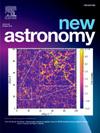Estimation of classical Cepheid’s physical parameters from NIR light curves
IF 1.9
4区 物理与天体物理
Q2 ASTRONOMY & ASTROPHYSICS
引用次数: 0
Abstract
Recent space-borne and ground-based observations provide photometric measurements as time series. The data points are nearly continuous over a limited observational interval or randomly scattered over a long period. The effect of interstellar dust extinction in the near-infrared range is only 10% of that measured in the visual (V) range. However, the sensitivity of the light curve shape to the physical parameters in the near-infrared is significantly lower. So, interpreting these types of data sets requires new approaches like the different large-scale surveys, which create similar problems with big data. Using a selected data set, we provide a method for applying routines implemented in R to extract most information of measurements to determine physical parameters, which can also be used in automatic classification schemes and pipeline processing.
We made a multivariate classification of 131 Cepheid light curves (LC) in J,H, and K colors by applying routines of R, where all the LCs were represented in 20D parameter space in these colors separately. Performing a Principal Component Analysis (PCA), we got an orthogonal coordinate system and squared Euclidean distances between LCs. The PCA resulted in 6 significant eigenvalues, which allowed us to reduce the 20-dimension to 6. We also estimated the optimal number of partitions of similar objects and obtained it equal to 7 in each color; their dependence on the period, absolute magnitude, amplitude, and metallicity are also discussed. We computed the Spearman rank correlations, and concerning periods and absolute magnitudes, the first three PCs had correlations at a very high significance level. Similar computations revealed significant relationships between the amplitude and the first two PCs, but the LCs depend only marginally on the metallicity in H and K colors.
The method shown can be generalized and implemented in unsupervised classification schemes and analysis of mixed and biased samples. The analysis of a sample of classical Cepheids observed only in near-infrared bands resulted in the information coded in the light curves being insufficient to determine the stars’ metallicity and identified the mass as the dominating quantity to form the shape of LCs in our sample.
从近红外光曲线估计经典造父变星的物理参数
最近的星载和地面观测提供了时间序列的光度测量结果。数据点在有限的观测间隔内几乎是连续的,或者在很长一段时间内随机分散。星际尘埃在近红外波段的消光效果仅为可见光波段的10%。然而,光曲线形状对近红外物理参数的灵敏度明显较低。因此,解释这些类型的数据集需要新的方法,比如不同的大规模调查,这在大数据中产生了类似的问题。本文以选定的数据集为例,提供了一种利用R实现的例程提取大部分测量信息以确定物理参数的方法,该方法也可用于自动分类方案和管道处理。采用R的例程对J、H、K三种颜色的131个造父变星光曲线(LC)进行多元分类,其中所有LC分别以这些颜色表示在20D参数空间中。通过主成分分析(PCA),我们得到了一个正交坐标系和LCs之间的平方欧几里德距离。PCA得到6个显著特征值,这使我们能够将20维减少到6维。我们还估计了相似物体的最优分区数,得到了每种颜色的最优分区数为7;讨论了它们与周期、绝对值、振幅和金属丰度的关系。我们计算了Spearman秩相关性,关于周期和绝对量级,前三个pc具有非常高的显著性水平的相关性。类似的计算揭示了振幅与前两个pc之间的显著关系,但lc仅略微依赖于H和K色的金属丰度。该方法可推广应用于无监督分类方案以及混合样本和有偏样本的分析。对一颗仅在近红外波段观测到的经典造父变星样本进行分析,发现光曲线中编码的信息不足以确定恒星的金属丰度,并确定质量是形成我们样本中lc形状的主导量。
本文章由计算机程序翻译,如有差异,请以英文原文为准。
求助全文
约1分钟内获得全文
求助全文
来源期刊

New Astronomy
地学天文-天文与天体物理
CiteScore
4.00
自引率
10.00%
发文量
109
审稿时长
13.6 weeks
期刊介绍:
New Astronomy publishes articles in all fields of astronomy and astrophysics, with a particular focus on computational astronomy: mathematical and astronomy techniques and methodology, simulations, modelling and numerical results and computational techniques in instrumentation.
New Astronomy includes full length research articles and review articles. The journal covers solar, stellar, galactic and extragalactic astronomy and astrophysics. It reports on original research in all wavelength bands, ranging from radio to gamma-ray.
 求助内容:
求助内容: 应助结果提醒方式:
应助结果提醒方式:


